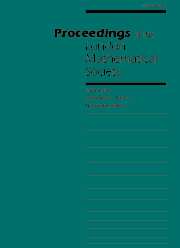Article contents
ABSOLUTE, RELATIVE, AND TATE COHOMOLOGY OF MODULES OF FINITE GORENSTEIN DIMENSION
Published online by Cambridge University Press: 22 August 2002
Abstract
We study finitely generated modules $M$ over a ring $R$, noetherian on both sides. If $M$ has finite Gorenstein dimension $\mbox{G-dim}_RM$ in the sense of Auslander and Bridger, then it determines two other cohomology theories besides the one given by the absolute cohomology functors ${\rm Ext}^n_R(M,\ )$. Relative cohomology functors ${\rm Ext}^n_{\mathcal G}(M,\ )$ are defined for all non-negative integers $n$; they treat the modules of Gorenstein dimension $0$ as projectives and vanish for $n > \mbox{G-dim}_RM$. Tate cohomology functors $\widehat{\rm Ext}^n_R(M,\ )$ are defined for all integers $n$; all groups $\widehat{\rm Ext}^n_R(M,N)$ vanish if $M$ or $N$ has finite projective dimension. Comparison morphisms $\varepsilon_{\mathcal G}^n \colon {\rm Ext}^n_{\mathcal G}(M,\ ) \to {\rm Ext}^n_R(M,\ )$ and $\varepsilon_R^n \colon {\rm Ext}^n_R(M,\ ) \to \widehat{\rm Ext}^n_R(M,\ )$ link these functors. We give a self-contained treatment of modules of finite G-dimension, establish basic properties of relative and Tate cohomology, and embed the comparison morphisms into a canonical long exact sequence $0 \to {\rm Ext}^1_{\mathcal G}(M,\ ) \to \cdots \to {\rm Ext}^n_{\mathcal G}(M,\ ) \to {\rm Ext}^n_R(M,\ ) \to \widehat{\rm Ext}^n_R(M,\ ) \to {\rm Ext}^{n+1}_{\mathcal G}(M,\ ) \to \cdots$. We show that these results provide efficient tools for computing old and new numerical invariants of modules over commutative local rings.
2000 Mathematical Subject Classification: 16E05, 13H10, 18G25.
Keywords
Information
- Type
- Research Article
- Information
- Proceedings of the London Mathematical Society , Volume 85 , Issue 2 , September 2002 , pp. 393 - 440
- Copyright
- 2002 London Mathematical Society
- 225
- Cited by

